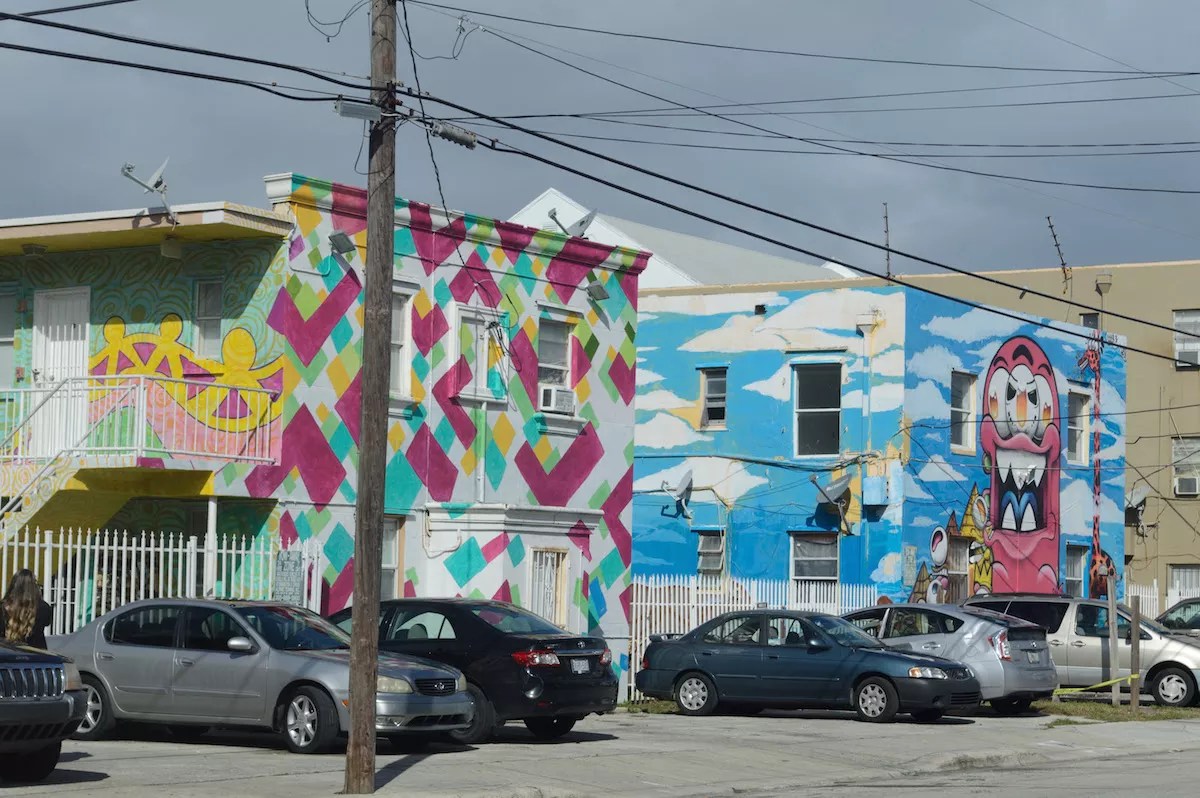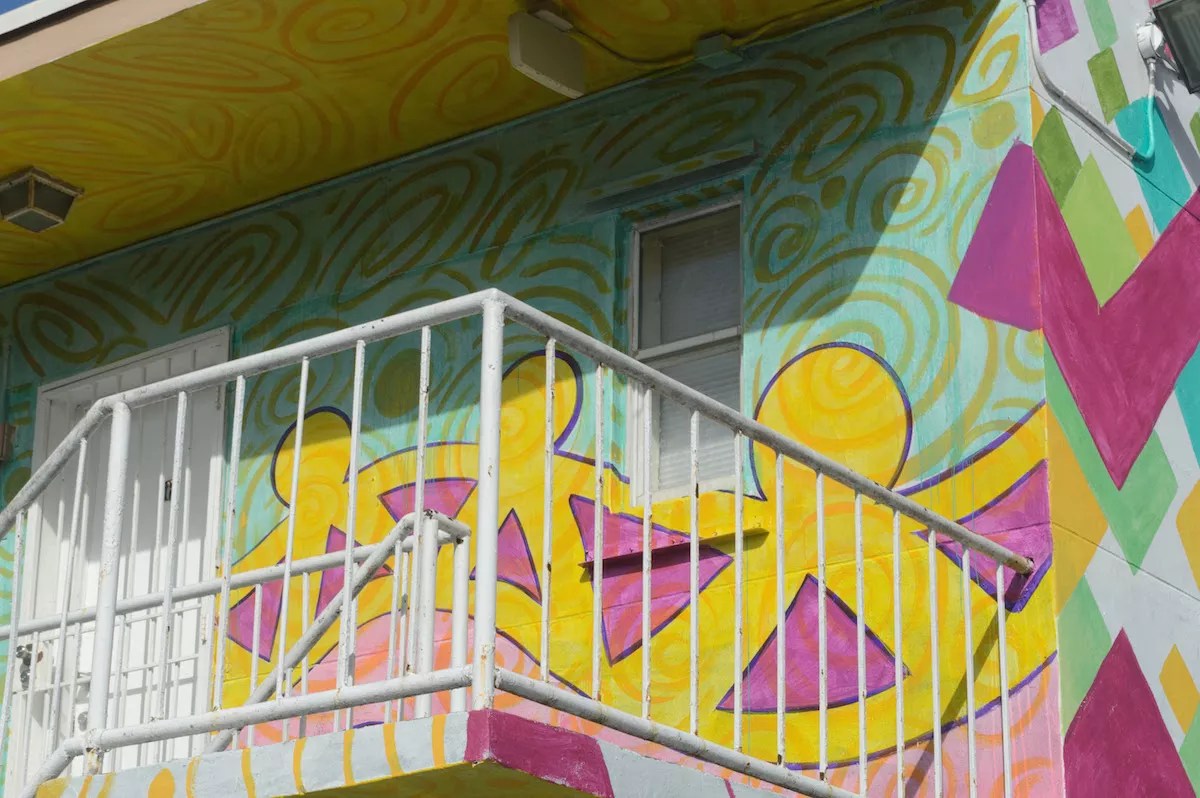
Photo by Mario Ariza

Audio By Carbonatix
Overtown lies just south of Wynwood, but Miami’s second-oldest neighborhood hasn’t benefited much from the mural-led development model. Urban blight – from dilapidated buildings and tagged-up walls to overgrown lots – has left most investors uninterested in developing the area. A series of five new murals painted this winter sought to deliver on the transformational promise of public art to Overtown residents. But is this art just painting over deeper issues?
Abe and Denise Vaknin are notoriously terrible landlords, so much so that the Miami Herald devoted a whole series to their troubles. The nine buildings they own are in such bad shape that the City of Miami has issued an order of foreclosure on the properties for unpaid fines and flagrant building code violations. Two of those buildings are in Overtown, and they received bright, colorful, and unique paint jobs during the mural project.
But now the nonprofit organization that executed the murals says it has yet to get paid and, because of the Vaknins’ legal woes, fears it might never see the money.
The Vaknins own 147 apartment units in Miami. They’ve also been investigated by WLRN, WPLG, and WTVJ for operating apartments with substandard living conditions in Overtown and Liberty City. The Houston Chronicle has documented similar issues with the pair’s properties in Texas.
Kyle Holbrook, founder of MLK Murals, the nonprofit that organized the art project, had no idea about the Vaknins’ checkered past. “First I hear of it,” he tells New Times.
The City of Miami filed suit against the Vankins in October 2014, claiming the New Jersey couple owed more than $2.4 million in unpaid fees for violating health and sanitation codes. Their buildings, covered in mold, lacking electricity, and with leaky plumbing, were transferred into the custody of a receiver after the Vaknins failed to show up in court. The city appoints receivers for properties when judges determine that the owners won’t act in good faith to try to repair them.
The Vaknins later sued Linda Leali, the court-appointed receiver, in October 2016, alleging she had mismanaged repairs after a fire.
Around that time, their new property manager, Norman Moodie, came up with the idea of painting the buildings.
“The area has a bad image from the past,” Moodie says. “What we want to do is change the attitude of people in Miami. The same thing that they are doing in Wynwood could be extended to benefit this area.”
Leali agreed to the aesthetic improvements, though her lawyers point out that the Vaknins have not yet made funds available for more serious repairs.
So Moodie hired Corey O’Brien, a local Miami artist, with whom he promptly had a falling out. O’Brien did not respond to New Times‘ requests for comment, but Moodie produced a police report alleging O’Brien vandalized the murals after he painted them. “He did it out of spite,” Moodie says.
Moodie wouldn’t comment on the exact nature of their disagreement, but it was MLK Murals that ended up cleaning the mess.

A colorful kids’ pattern now livens up 140 NW 17th St.
Photo by Mario Ariza
“‘MLK’ stands for ‘Moving the Lives of Kids,'” says Holbrook, leaning on the newly painted fence surrounding 1710 NW First Pl., a Vaknin property. His artists transformed both of the two-story apartment buildings into works of art. Some of the artists, like Louis Jensen and Tarschilla Schubert, traveled from as far away as London and Dubai.
One of the murals features polychromatic abstract triangles and outlines of dancing children. “The kid pattern is kinda symbolic of the collaboration,” Holbrook explains. “We had serious artists but also kids who were painting for the first time, so it was kind of an ice-breaker. We got them pizza and juice and even paid some of them for their work.”
At a news conference January 12, a lawyer for the Vaknins, Marie Smith, praised the murals: “You can’t get a better paint job than this.”
But despite Moodie’s claims that the art has significantly raised the value of the properties, the Vaknins have yet to pay.
Contracts provided by MLK Murals to New Times show the Vaknins agreed on December 16, 2016, to pay MLK Murals $3,750 upon completion of the work. Holbrook says Moodie keeps moving the goalposts. “He’s told us we need to do one last little thing five or six times.”
The murals on the Vaknin properties were part of a larger project. MLK Murals also painted walls owned by the Overtown CRA, TECO Energy, and Pinnacle Housing Group. Only the Vaknins haven’t paid.
Reached by phone, Smith, the Vaknins’ lawyer, said the artists would receive payment. But Moodie tells a different story. In an email he sent to MLK Murals just hours after New Times spoke to Smith, he claimed that, because of design discrepancies, the nonprofit would not get paid until its “incomplete and hastily” done work was finished and some splattered paint was removed.
When a New Times reporter visited the sites, workers were repairing and updating the two Overtown properties owned by the Vaknins. Moodie says the work is 95 percent complete.
The legal battle between the Vaknins and their receiver is still ongoing in court. In the meantime, the artists are losing hope of getting compensation. After months of wrangling, Holbrook doesn’t think his organization will ever be paid.
“But whatever, we still did a great mural, a great project,” he says. “The idea was just bringing some art to where it was needed. Those people see it every day; we get people saying ‘Thank you – we love it’ every day. So that makes it worth it.”